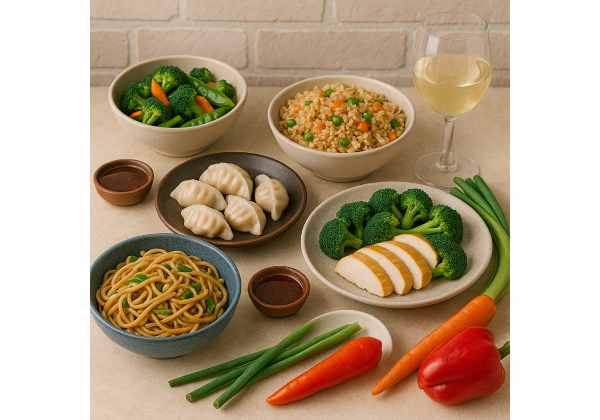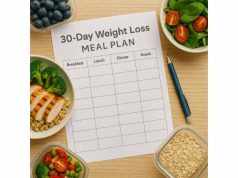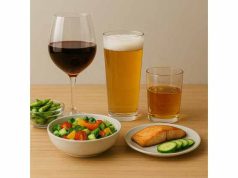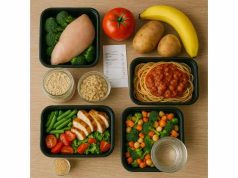
Chinese restaurants can absolutely fit a weight-loss plan. The variety is a strength: steamed seafood, stir-fried vegetables, tofu, brothy soups, and rice you can portion to your goals. The challenge is portion size and sauces—many are tasty but sweet or oily. This guide shows you how to scan a menu quickly, pick filling dishes, and customize orders so you leave satisfied, not stuffed. If you want a refresher on daily calorie targets, macro balance, and sample menus before you go, start with our page on calorie targets and practical meal planning, then come back ready to order with confidence.
Table of Contents
- What to order for weight loss
- Build a balanced Chinese plate
- Smart swaps and sides
- Common menu traps and fixes
- Drinks, sauces, and sodium
- Low-carb, vegetarian, and gluten-free
- Ready-to-order picks and macros
- Frequently Asked Questions
What to order for weight loss
Chinese menus are easier to navigate once you know where to look: steamed, poached, and stir-fried with light sauce are your friends; deep-fried, breaded, and syrupy dishes are occasional treats. Build your order around lean proteins, high-volume vegetables, and rice you can portion by the spoon.
Best entrée categories (ask for light sauce and less oil)
- Steamed protein with vegetables: shrimp and broccoli, chicken with mixed vegetables, tofu and bok choy, fish with ginger and scallion.
- Stir-fried, not breaded: moo goo gai pan (chicken with mushrooms), beef with snow peas, garlic string beans with tofu, kung pao without breading and sauce on the side.
- Broths and clay pots: hot and sour soup, egg drop soup, seafood tofu soup, braised eggplant with steamed tofu (light oil).
- Vegetable-forward dishes: Buddha’s Delight (mixed vegetables and tofu), sautéed Chinese greens (gai lan, choy sum), mapo tofu (ask for light oil).
Rice and noodles, the smart way
- Choose steamed jasmine or brown rice and serve ½–1 cup yourself.
- If you love noodles, pick rice noodles in broth (pho-style bowls appear at many pan-Asian spots) or lo mein light oil and share.
- Skip fried rice most nights; if you order it, request half rice, double vegetables, and no extra oil.
Flavor add-ons that do not blow your budget
- Chili crisp (small amount), chili-garlic paste, vinegar, ginger, scallions, white pepper, and toasted sesame seeds (sprinkle).
- Soy sauce can be salty—use a light drizzle or ask for low-sodium soy.
Customization phrases that work
- “Light sauce and less oil, please.”
- “Can you steam the protein and vegetables and serve sauce on the side?”
- “No breading on the chicken.”
- “Brown rice, half portion.”
- “Extra vegetables instead of extra noodles.”
If you want a quick primer on sustainable fat-loss fundamentals before you dine, review our guide to safe weight-loss strategies and then use the tactics above to match the menu.
Build a balanced Chinese plate
A simple template works in any regional style—from Cantonese and Sichuan to American Chinese: protein anchor + high-volume vegetables + smart starch + measured fats. This approach keeps meals filling and predictable even without exact nutrition facts.
Protein anchor (25–45 g)
Choose shrimp, scallops, white fish, chicken breast, lean beef, pork tenderloin, or tofu. Ask how dishes are cooked; most kitchens will steam or stir-fry with less oil if you request it. A double side of tofu or an extra protein add-on often costs less than a second entrée and prevents nibbling later.
High-volume vegetables
Load the plate with broccoli, snow peas, bok choy, napa cabbage, Chinese broccoli, mushrooms, eggplant, or mixed vegetables. Say “extra vegetables” when you order. Bitter greens with garlic are especially satisfying for minimal calories.
Smart starch (½–1 cup cooked)
- Steamed rice: serve yourself with a spoon so you stay within your budget. If you plan on dessert or a drink, stick to ½ cup.
- Noodles: noodle soups (beef, chicken, seafood) tend to be lower in oil; request more vegetables, less noodle.
- Buns and pancakes: treat scallion pancakes, bao, and moo shu pancakes as extras—share, or swap them for rice.
Measured fats (flavor, not floods)
Peanut oil, sesame oil, and sauces add richness quickly. Ask for less oil, and use sesame oil as a few drops at the table. Sprinkle peanuts or cashews rather than relying on saucy, nut-heavy dishes.
Plate examples
- Steamed shrimp and broccoli with sauce on the side, ½ cup brown rice, and hot and sour soup starter.
- Moo goo gai pan (light sauce) with double vegetables + ½ cup rice; add tofu if you want extra protein.
- Mapo tofu (light oil) with garlic bok choy and ½ cup rice.
For a visual cue on restaurant portions, see our simple plate method and use it to guide rice, noodle, and protein amounts at the table.
Smart swaps and sides
Small choices make big differences in Chinese cuisine. Use these swaps to keep flavor high and calories focused on what fills you up.
Swap the cooking method
- Fried → steamed or stir-fried light oil: swap General Tso’s (breaded) for chicken and broccoli or kung pao unbreaded.
- Crispy beef → beef with snow peas (ask for light sauce).
- Crab rangoon → edamame or cucumber salad.
Adjust the sauce
- Choose garlic, black bean, oyster, or white sauce with light oil over thick, sugary glazes like sweet and sour, orange, or honey sauces.
- Say “sauce on the side” and dip; you will use less and taste more of the vegetables and protein.
Upgrade the starter
- Pick hot and sour or egg drop soup (broth-based, filling) instead of fried appetizers.
- Choose steamed dumplings over fried; share and pair with a vinegar-heavy dip.
Rice and noodle tweaks
- Steamed rice beats fried rice most nights. If you order fried rice, ask for half rice, double veg, extra egg, and no extra oil.
- With noodles, request more vegetables, less noodle, and light oil; add protein (shrimp, chicken, tofu).
Sides that add fullness for few calories
- Garlic string beans (light oil), stir-fried bok choy, sautéed spinach, steamed mixed vegetables.
- Cucumber or seaweed salads (vinegar-based).
For more ideas that keep portions generous without overshooting calories, browse our roundup of high-volume, low-calorie foods and pair them with your entrée.
Common menu traps and fixes
Even with good intentions, calories can creep in through breading, sugar, oil, and big bowls of starch. Spot these patterns and you will stay on track.
Trap: Breaded and fried mains
Think General Tso’s, orange chicken, sesame chicken, crispy beef. These start with batter, then get coated in sweet sauce.
Fix: order unbreaded versions (many kitchens will do this), choose stir-fried chicken and broccoli, kung pao unbreaded, or beef with snow peas. Ask for sauce on the side and less oil.
Trap: Sugary glazes and heavy reductions
Sweet-and-sour, orange, honey walnut, and some “chef specials” can pack more sugar than you expect.
Fix: pick garlic, black bean, white, or brown sauces light. Add chili, vinegar, or ginger at the table for brightness without sugar.
Trap: Big bowls of rice or noodles
A heaping bowl can equal multiple servings.
Fix: serve ½–1 cup rice with a spoon; box leftovers early. For noodles, request extra vegetables and less noodle.
Trap: Oil layers
Wok cooking is fast and hot; it does not need a lot of oil, but some restaurants pour generously.
Fix: say “less oil, please” or “stir-fry with a tablespoon of oil”; many kitchens will accommodate.
Trap: Fried appetizers
Egg rolls, crab rangoon, and fried dumplings add up fast.
Fix: choose steamed dumplings, edamame, cucumber salad, or soup to start.
If your progress stalls despite “eating healthy” out, scan these patterns and adjust. Our checklist of common diet mistakes can help you spot quick wins.
Drinks, sauces, and sodium
Drinks that work
- Water (still or sparkling) with lemon or lime.
- Unsweetened tea (hot jasmine, green, oolong) or black coffee.
- If you want alcohol, choose one light beer or one small pour of wine, then switch to sparkling water. Alternate each drink with water.
Sauce strategy
- Use soy sauce lightly; a small splash goes far. Ask for low-sodium soy if available.
- Elevate flavor with black vinegar, rice vinegar, fresh chilies, ginger, garlic, and scallions instead of extra sugary sauces.
- Sesame oil is fragrant—a few drops at the table beats a heavy pour in the pan.
Sodium notes, made practical
Restaurant Chinese food can be salty. Most people tolerate MSG without issue; the bigger lever for water retention is total sodium. Balance the day with plenty of water, extra vegetables, and sauce on the side. The next meal can be lower-sodium with lean protein, fruit, and vegetables.
Want a quick refresher on low-calorie beverage choices and hydration timing? See our guide to smart hydration for weight loss.
Low-carb, vegetarian, and gluten-free
Low-carb approach
Build plates around protein + non-starchy vegetables: chicken and broccoli, beef with snow peas, shrimp with mixed vegetables, tofu and bok choy. Ask for no breading, light oil, and sauce on the side. If you want rice, keep it to ¼–½ cup and add more vegetables.
Vegetarian or plant-forward
Anchor meals with tofu and vegetables: Buddha’s Delight, mapo tofu (ask for light oil), garlic eggplant, sautéed greens, mixed vegetable stir-fries. Request extra tofu for protein and steamed rice in a small portion.
Gluten-free considerations
Soy sauce and many brown sauces contain wheat. Ask if the kitchen can use tamari or plain salt, pepper, and cornstarch for thickening. Stick to steamed dishes, simple stir-fries, rice, egg drop or hot and sour soup (confirm thickener), and grilled/steamed seafood.
Dairy-light and lighter fats
Chinese cuisine is mostly dairy-free by default. Keep oils measured and choose lean proteins plus vegetables to manage calories.
If you are choosing between low-carb and lower-fat approaches, compare trade-offs in our overview of low-carb and low-fat styles and use the one that keeps you fullest with the least effort.
Ready-to-order picks and macros
Use these examples to assemble satisfying meals at common calorie targets. Macros are approximations based on typical restaurant portions; adjust to your appetite and daily plan.
~400–500 calories (lighter meals)
- Steamed shrimp and broccoli + sauce on the side + ½ cup brown rice; start with egg drop soup. (~35–40 g protein)
- Buddha’s Delight (light sauce) + garlic bok choy; small side of rice if desired. (fiber-forward, ~20 g protein with tofu)
- Chicken and snow peas (light sauce) + cucumber salad. (~35 g protein)
~550–700 calories (moderate meals)
- Moo goo gai pan with double vegetables + ½ cup rice. (~40 g protein)
- Mapo tofu (light oil) + steamed mixed greens + ½ cup rice. (~30–35 g protein)
- Beef with broccoli (light sauce) + hot and sour soup + ½ cup rice. (~40 g protein)
~700–850 calories (bigger appetite or training day)
- Shrimp with lobster sauce (light) + garlic string beans + ¾–1 cup rice. (~40 g protein)
- Chicken and broccoli + steamed pork dumplings (3–4) + ½ cup rice. (~45 g protein)
- Seafood noodle soup (extra vegetables, less noodle) + side greens. (~35–40 g protein)
Macro cues for any order
- Protein: target 25–45 g per meal—add tofu or extra shrimp/chicken if needed.
- Fiber: include vegetables and broth-based starters to stay full.
- Fat: use oils and nuts as accents, not the base of the dish.
If dessert calls, share mango pudding, fresh fruit, or a single scoop of sorbet and trim rice or noodles earlier in the meal.
Frequently Asked Questions
What is the healthiest order at a Chinese restaurant for weight loss?
Pick a steamed or lightly stir-fried entrée with extra vegetables and sauce on the side. Add ½ cup steamed rice or skip it and add a broth-based soup. Favor shrimp, chicken, fish, or tofu. Season with chili, vinegar, and ginger instead of heavy sauces.
Is fried rice off-limits if I am trying to lose weight?
No—modify it. Request half rice, double vegetables, extra egg or tofu, and no extra oil. Pair with a vegetable side and skip appetizers. If that still pushes your calories high, choose steamed rice and a vegetable-heavy entrée instead.
Which sauces are best for weight loss at Chinese restaurants?
Choose garlic, black bean, white/ginger-scallion, or brown sauce light. Ask for sauce on the side. Limit sweet and sour, orange, and honey glazes to occasional splurges; they are higher in sugar and often paired with breaded meats.
How do I handle big portions of rice and noodles?
Serve yourself ½–1 cup rice with a spoon and box leftovers early. For noodles, request more vegetables and less noodle, and choose broth-based bowls when possible. Filling the plate with vegetables first keeps portions in check.
Can I eat Chinese takeout and still lose weight?
Yes. Order steamed protein and vegetables, sauces on the side, and brothy soups. Choose steamed rice over fried. Share or save half for later. Hydrate well and keep the next meal lean and vegetable-heavy to balance sodium.
What are good low-carb options at a Chinese restaurant?
Go for chicken and broccoli, beef with snow peas, shrimp with mixed vegetables, or tofu and bok choy—all unbreaded, light oil, sauce on the side. Add extra vegetables and skip rice, or keep to ¼–½ cup if you want some starch.
Are steamed dumplings a healthy choice?
They can fit. Steamed beats fried. Have 3–4 dumplings as a starter with vinegar-based dipping sauce, then choose a vegetable-heavy entrée. If you want dumplings as a meal, add a broth-based soup and greens for volume.
References
- Calorie reformulation: a systematic review and meta-analysis examining the effect of manipulating food energy density on daily energy intake — 2022 (Systematic Review & Meta-analysis)
- Downsizing food: a systematic review and meta-analysis examining the effect of reducing served food portion sizes on daily energy intake and body weight — 2022 (Systematic Review & Meta-analysis)
- About Sodium and Health | Salt | CDC — 2024 (Government Guidance)
- Re-evaluation of glutamic acid (E 620), sodium glutamate (E 621), potassium glutamate (E 622), calcium glutamate (E 623), ammonium glutamate (E 624) and magnesium glutamate (E 625) as food additives — 2017 (Safety Assessment)
- Coeliac Disease A Gluten Free Diet — 2025 (NHS Guidance)
Disclaimer
This article is for general education only and does not replace personalized medical advice, diagnosis, or treatment. Speak with your healthcare professional about diet changes—especially if you have diabetes, celiac disease, kidney or liver conditions, are pregnant, or have a history of disordered eating.
Share and follow
If this guide helped you order confidently at Chinese restaurants, consider sharing it with a friend who eats out often. For more practical nutrition guides, follow us on the platform you use most—Facebook, X, or another network you prefer.










